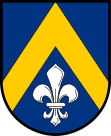Nižní Lhoty
| Nižní Lhoty | ||||
|---|---|---|---|---|
|
||||
| Basic data | ||||
| State : |
|
|||
| Region : | Moravskoslezský kraj | |||
| District : | Frýdek-Místek | |||
| Area : | 377 ha | |||
| Geographic location : | 49 ° 39 ' N , 18 ° 27' E | |||
| Height: | 359 m nm | |||
| Residents : | 281 (Jan. 1, 2019) | |||
| Postal code : | 739 51 | |||
| traffic | ||||
| Street: | Dobrá - Pražmo | |||
| structure | ||||
| Status: | local community | |||
| Districts: | 1 | |||
| administration | ||||
| Mayor : | Marie Gryžboňová Mališová (as of 2008) | |||
| Address: | Nižní Lhoty 71 739 51 Dobrá |
|||
| Municipality number: | 552526 | |||
| Website : | www.niznilhoty.cz | |||
Nižní Lhoty (German Unter Ellgoth ) is a municipality in the Czech Republic . It is located eight kilometers southeast of Frýdek-Místek and belongs to the Okres Frýdek-Místek .
geography
Nižní Lhoty is located on the right bank of the Morávka in the Beskid foothills. The Hyundai Motor Manufacturing Czech plant is located north of the village . East of the gain of the influent passing dam Žermanice applied supply channel Morávka-Žermanice , the water from the Morávka in the Lučina passes. To the west rise the hills Vrchy (433 m) and Strážnice (438 m).
Neighboring towns are Vojkovice in the north, Bukovice in the northeast, America in the east, Kamenité and Vyšní Lhoty in the southeast, Kamenec and Záhoří in the south, Skalice in the west and Na Kamenci and Nošovice in the northwest.
history
The Waldhufendorf emerged during the colonization of the area at the transition from the 13th to the 14th century. The first written mention of the place named after its locator Rudger as Rudgerova Ves ( Rudgersdorf ) took place in 1305. It is assumed that the mention of a village Rozkova Lhota from 1450 also refers to this place.
The village originally belonging to the dukes of Teschen came to the city of Friedeck , which pledged it together with surrounding villages to Ernst von Tworkau in 1434 . Nižní and Vyšní Lhoty were mentioned for the first time. In 1573 Duke Wenzel von Teschen sold the village together with the entire Friedecker lordship to the brothers Georg and Matthias von Logau and thus finally separated it from the Duchy. In the following time the place was also called Dolní Lhota or Spodní Lhota . Between 1607 and 1739 only the name Nižní Lhoty can be found in the land registers .
After the abolition of patrimonial Unter Ellgoth formed from 1850 a community in the district of Teschen. In 1867 a wooden bell tower was built in the village. The Czech name Dolní Lhota has been used since the end of the 19th century . In 1870 a school opened in the village, until then Dobrá had been the school location. From 1908 the place belonged to the Friedeck district. In 1930 the village had 457 inhabitants.
According to the Munich Agreement , Polish troops occupied part of the village on October 1, 1938. The Czech-Polish border ran through the village until 1939, and the 25 houses north of the Račok brook became Polish. After the German occupation, Unter Ellgoth belonged entirely to the Protectorate of Bohemia and Moravia. After the Second World War Nižní Lhoty was assigned to the Okres Místek and came after its dissolution in 1961 as a district of Nošovice to the Okres Frýdek-Místek . Between 1952 and 1955 a cemetery was laid out on a hill above the village. From 1975 Nižní Lhoty belonged to the Dobrá municipality under the name Dobrá 3 - Nižní Lhoty . The Nižní Lhoty community has existed again since 1990.
Community structure
No districts are shown for the municipality of Nižní Lhoty. To nižní lhoty heard the settlement Bukovice II ( Bukowitz ).
Attractions
- Skalická Morávka natural monument
- Chapel of the Blessed Virgin Mary of Frýdek, consecrated in 1946 on the site of the bell tower
- small chapel on the outskirts of Nošovice

